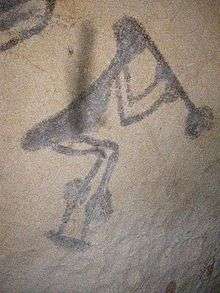Cohoba
Cohoba is an old Taíno Indian transliteration for a ceremony in which the ground seeds of the cojóbana tree were inhaled in a twin-nasal, Y-shaped pipe (also called Cohoba), producing a psychedelic effect.[1] The cojóbana tree is believed by some to be Yopo, Anadenathera peregrina,[2] although it may have been a generalized term for psychotropics, including the quite toxic Datura and related genera (Solanaceae). The corresponding ceremony using cohoba-laced tobacco is transliterated as cojibá. This corresponds culturally to the practice of drug-induced "astral traveling" so common to the Americas and elsewhere.

The practice of snuffing Cohoba was popular with the Taíno and Arawakan peoples, with whom Christopher Columbus made contact.[3]
Fernando Ortiz, the founder of Cuban Cultural Studies, offers a detailed analysis of the use of cohoba in his important anthropological work, Contrapunteo cubano del tabaco y el azúcar.[4]
References
- Aquino, Luis Hernández (1977). Diccionario de voces indígenas de Puerto Rico. Editorial Cultural. ISBN 84-399-6702-0.
- Hallucinogenic Plants by Richard E. Shultes. Golden Press, New York, 1976.
- The Role of Cohoba in Taino Shamanism. Constantino M. Torres, in Eleusis No. 1 (1998)
- Contrapunteo cubano del tabaco y el azúcar, Additional chapter VIII, Fernando Ortiz (Madrid: Cátedra, 2002).